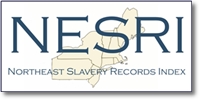
From the cover of one volume of the church records, maintained at the Connecticut State Library.
The Connecticut State Library maintains Church records from 1630 to 1920. The records, primarily of Congregational churches, were indexed in 1941 on index cards, and are organized as alphabetical lists, by town and church, in the 1960s. They are now also accessible on Ancestry.com in a collection titled “Connecticut, U.S., Church Record Abstracts, 1630-1920”.
Connecticut NESRI partners, particularly Dennis Culliton and Brayton Price of the Witness Stone Project and Professor Leah Glaser of the Public History Program of Central Connecticut State University (CCSU), have organized a project to index a subset of records from the Connecticut Church Records Abstracts that may have documented enslavement. CCSU students have assisted in coding records from 31 churches, and the datasets are being reviewed and processed for uploading to NESRI.
NESRI’s Connecticut Church Records project illustrates many of the challenges of indexing records of enslavement that were originally developed for other purposes. In the records, people are not consistently identified as being enslaved. When a record may describe an enslaved person, but there is ambiguity, NESRI’s approach is to index the record while also describing the ambiguity in the record, so that future research can clarify the ambiguity. Otherwise, enslaved people are left out of the historical record only because their enslavers were ambiguous or sloppy in documenting the facts of their enslavement.
What a our rules or criteria? While our general evidence standard to include a record is the “balance of evidence” not the “absence of reasonable doubt,” we document ambiguities in the record. We based our decisions on the following indications that a church record notation refers to an enslaved person:
- The record described the person as a “negro servant of” another person.
- The person had no surname – for example listed only as “Cleah, child of Bess.”
- An exception can involve records of marriages where the maiden name of the wife is not recorded, such as “Abigail, m. Abiel Smith” when there is no indication that the husband is a black person.
- The record does not describe enslavement before 1650, because slavery was legalized in Connecticut in 1650.
A record may concern a free person who may have been enslaved in the past. The 1790 national census for Connecticut revealed that close to 50% of Black people in Connecticut were enslaved at that time. Prior to 1790, the precent of Black people who were not enslaved was considerably lower. Fore example, 1717 it was illegal for a free negro to reside anywhere in the colony. (Greene, 2017, page 312) So any record of a black person before 1790 would present a 50% chance or better that the person involved had been enslaved in the past. After 1790, the probability that a free black person had been previously enslaved declines. record declines. In Connecticut, a gradual abolition law was passed in 1784 freeing persons born to enslaved mothers when they reached 25 years old, and Connecticut officially ended slavery in 1848. Thus someone who died in 1860 would not have been enslaved in 1860, but he or she might have been enslaved at an earlier time. For such records, other information in the record should be considered.
The records describe religious events, and the records describe the events and contain search terms called “Tags” that are used in retrieval and analysis of records. The following is a listing of the index terms, and the capitalized expressions are search tags.
- adm.ch: Admitted to church (ADM)
- adm.com: Communicant (ADMCOM)
- bp: Baptism (BPT)
- conf: Confession (CNF)
- d: Death (DEATH)
- dism: Dismissed from membership (CHDSP)
- excom: Excommunicated (EXCOM)
- mem.ch: Member of Church (CHMEM)
- m: Marriage (MRGE)
- o.c: Owned the covenant – a pledge that bound one to adhere to the doctrine of the church. (ONCOM)



